Editor’s Note:
Potatoes are often overlooked by preppers. And I really can’t understand why.
They are cheap, easy to store without electricity, high in carbohydrates (exactly what you need in a crisis) and you can make a lot of dishes, including bread if you want to.
Besides that, potatoes hold the distinction of being one of the easiest and most prolific crops to grow. Not only do they grow well under a range of conditions, and offer the ability to select from a number of different growing media, but in some climates it is possible to get two harvests per year. Potatoes would make one of the best post apocalyptic crops.
If you are not in a position to grow your own potatoes and have either been gifted with bushels of spuds from green-thumbed friends, or have found incredible sales on these starchy vegetables, you could still find yourself in a pickle about what to do with more potatoes than you and your family can eat.
Certainly potatoes do have a superior shelf life compared to most other vegetables.
1. Extended Dry Storage – Root Cellars
Potatoes can be readily stored through the winter, which makes them a good go-to source of nutrition when not much else may be available or growing. We’ve all watched our potatoes slowly rot or sprout in the kitchen, so just what are the best methods of extending your dry storage time?
Your first step should be to sort through your potatoes. Any potatoes that have visible damage, including bruises or breaks on the skin should NOT be stored. These potatoes will rot a lot more rapidly than others, and they could spread a rot or infection to the rest of your potatoes. It will be incredibly disheartening to lose your entire store of potatoes.
The right storage spot is a key part to ensuring that your potatoes do not rot, green, or sprout. A root cellar, basement, or seldom opened cabinet in your kitchen will suffice. It’s important that your potatoes are not exposed to moisture and light.
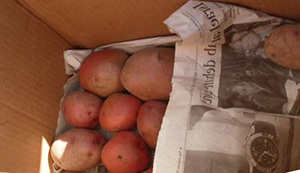 While you want to keep out moisture and light, you do not want to keep your potatoes locked up in an airtight container. Good ventilation is important. Store them in ventilated containers, or even wicker baskets with a sheet of newspaper between each layer of potatoes. The newspaper will not only help to keep the potatoes separated for good aeration, but can also work to absorb moisture in the air.
While you want to keep out moisture and light, you do not want to keep your potatoes locked up in an airtight container. Good ventilation is important. Store them in ventilated containers, or even wicker baskets with a sheet of newspaper between each layer of potatoes. The newspaper will not only help to keep the potatoes separated for good aeration, but can also work to absorb moisture in the air.
Ideally your storage space should be between 35 and 50 degrees Fahrenheit. Lower temperatures will alter the taste of the potatoes, and higher temperatures could lead to an advancement in decay.
Check you spuds periodically. Here are some signs of potential problems you should be aware of.
- Withered skin
- Soft to the touch
- Green coloration
- Sprouting
- Mold
- Bad smell
Related: How to Tell When Your Canned Foods Become Spoiled?
One trick in the prepper arsenal when it comes to potato storage is to take the steps needed to cure the potatoes for long-term storage. This is a fairly simple process that takes a few weeks, but will ensure you have potatoes that are much less susceptible to rot.
In a dark and cool area spread your potatoes out on a few layer of newspapers. The temperature should be between 50 and 60 degrees Fahrenheit. Leave the potatoes undisturbed for just over two weeks. What this does is thicken up and dry the skins of the potatoes a litter better for extended storage.
Avoid washing your potatoes prior to storage, and be certain that you are not storing them near fruits. Fruits release a chemical known as ethylene, which could make your potatoes sprout.
2. Dehydrating Potatoes
We’ve likely all enjoyed a dinner with potatoes that came out of the box as dried white flakes. With a bit of water and milk the potatoes reconstitute into mashed potatoes that are much more familiar in appearance.
You can take steps to dehydrate your potatoes in flake form, or in slices. The process is very similar for both.
Having a vegetable steamer and dehydrator will make the process incredibly simple for you.
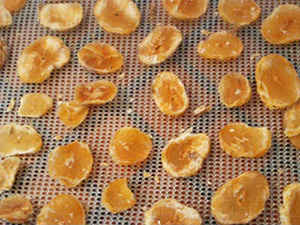 Storing your potatoes in slices:
Storing your potatoes in slices:
- Thoroughly wash and peel your potatoes. If you prefer to keep the potato peels on the spuds then you can do so
- Slice the potatoes evenly, using a mandolin slicer, so that they are 1/8” thick
- Layer your potatoes on the vegetable steamer and steam the slices for 5 minutes
- Move the potatoes to the trays of your dehydrator
- Set your dehydrator to 130 degree Fahrenheit, and dry the potatoes until they are thoroughly dried out
Once dried you can vacuum pack your potato slices or store them in airtight containers. To reconstitute them simply boil them until they are soft. You can also put a handful of the dried potatoes into a soup to simmer slowly with the rest of your ingredients.
Related: How to Make Powdered Eggs
Storing your potatoes as flakes will also allow you to create individual servings that could prove to be worth their weight in gold should you need to rely on them.
Storing your potatoes as flakes:
- Thoroughly wash and peel your potatoes
- Chop them up into cubes
- Place the cubed potatoes into a pot with just enough water to cover, and boil them over medium heat until they are soft
- Drain the water and mash them until they are smooth; be sure not to add any milk or butter, or even salt
- Layer your mashed potatoes out the trays of your dehydrator, lined with parchment paper
- Set your dehydrator to 140 degrees Fahrenheit dry for up to 8 hours, or until all of the moisture has been removed from the potatoes
- Remove chunks of the dehydrated potatoes and pulse them in your blender until you get the desired size of flakes
- Store your potato flakes in airtight containers or jars until you need them. Properly stored, they’ll keep for up to a full year
Reconstitute them by adding boiling water, milk, butter, and other seasonings to taste.
3. Freezing Potatoes
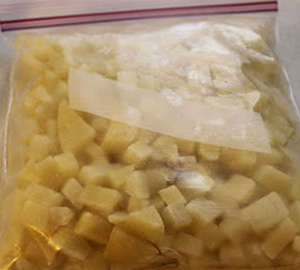 Freezing is definitely one method of storing your potatoes for later use, but it is not always the most practical choice for those for whom a loss of electricity is a concern. As a prepper it’s important to consider the most practical choices, choices that are similar to those who are currently living off the grid.
Freezing is definitely one method of storing your potatoes for later use, but it is not always the most practical choice for those for whom a loss of electricity is a concern. As a prepper it’s important to consider the most practical choices, choices that are similar to those who are currently living off the grid.
While a freezer is not an impossibility when you’re living off the grid, it’s a huge electricity vampire and is not always ideal for the storing of food that can be preserved using alternate methods.
To freeze your potatoes you can peel and cube them, and then par-boil them so that they are just too firm to be mashed easily. Once drained and cooled, you can store your potato cubes in freezer bags, or make use of a vacuum seal system to store them in individual portions that can be used when needed.
4. Canning Potatoes
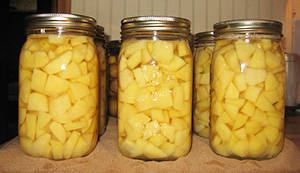 When you think of canning you likely think of that bumper crop of green beans or of whipping up a batch of jam to preserve. Potatoes can also be canned, and this does serve as a good method of storage; particularly if you are lacking in dry storage space in your root cellar.
When you think of canning you likely think of that bumper crop of green beans or of whipping up a batch of jam to preserve. Potatoes can also be canned, and this does serve as a good method of storage; particularly if you are lacking in dry storage space in your root cellar.
The canning process for potatoes is just as it is for other items that you are canning. To prepare your potatoes you should peel and dice them to about ½” cubes. Boil the potatoes until just cooked, but not overly soft. Drain and then spoon into your prepared jars. Add a teaspoon of salt to quart-sized jars, and then fill up with fresh boiling water. Seal the jars using your standard methods.
Smaller potatoes can be stored in large jars whole. Simply open, heat, and enjoy when you are in need of them.
The reliable potato is often overlooked, and given a bad rap due to being high in calories and carbohydrates. However, they are more than just the starchy start of fries. Let’s not forget about the Irish Potato Famine. They can keep you and your family nourished when it matters most.
You may also like:
 What Happens If You Put Banana Peels In Your Garden?
What Happens If You Put Banana Peels In Your Garden?
The ‘Superweed’ That Saved Large Communities During The Great Depression (Video)
EMP Survival Stockpile: What Are You Still Missing?
30 Lost Ways of Survival from 1880 We Should all Learn
Photo Credits: Prepared for That

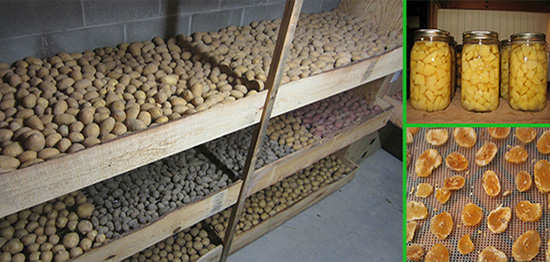













Just to weigh in on the freezing part, My family had great luck with roasting a 10# sack potatoes in a large roasting pan with rack inserted in the bottom to keep the cooking potatoes off the bottom. Roast until near fully cooked. The water beneath the rack can be saved for making pancakes, biscuits or soups.
Cool the potatoes until they are cool enough for the kids to handle. peel if desired, saving the peels. The fully cooked potatoes can be frozen whole. We ran some under-cooked potatoes through the Kitchenaid shredder and packaged into sandwich bags for single servings & larger freezer bags for family meals. They can be individually spiced to suit each persons taste. When freezing, lay out single layers on cookie sheets to freeze solid, then they can stacked into used bread sacks for longer term storage. The double wrapping reduces freezer burn significantly.
Other of the under-cooked were cut in small pieces and bagged for use in quick soups or fried potatoes. The fully cooked whole potatoes could be heated in a microwave for quick baked potatoes or thawed to room temperature and cut up for salads.
Depending on the size of whatever we used the oven to cook, we found we could companion roast potatoes in smaller pots and add little cooking time. The lid on the potato cooking pot served to steam cook them over a greater range of temperatures as long as care was used. Companion cooking with cakes proved adventurous and a few times disastrous to a cake or two until the kids acquired the strength to hold the door and not allow it to slam closed.
I froze some and canned some and didn’t like either one. Ended up throwing them out. We can grow potatoes year round here in the south. If you store them raw, DO NOT wash them first !
the dehydrated slices remind me of a product that a processing plant (jr simplot company) my mother worked at when I was a kid but they never brought it to market. if they were dropped in very hot oil they would puff up and feel as you ate them like a cheese puff but a very different taste from the cheese puff though. and it know that they lasted in a jar for more the 5 years
Thank you!
Jimbow…ah my mother also worked at JR Simplot’s for 20 years…..she worked hard, but did not bring home any fixing secrets. Regards
I have been storing potatoes in an air tight sealed bucket in my garage and went to check on them after reading this article. There is all kinds of moisture inside the bucket and few potatoes were moldy. I dont have a dark and cold place to store them. I have dehydrated some and may also can some. Any other suggestions for storage?
My grandpa used to put powdered lime on them, and kept them in the barn.
I would the try keep them in the cabinet or a closet. My problem/question is: How do I keep ants, bugs, roaches from getting into them and flooding the house with bugs.
I store mine away from onions and fruits, (not in the kitchen), spread out in a large drawer, covered with. a towel, on a closet floor, in a constant 55F room. They get plenty of air circulation and no issues with pests.
Re: canning potatoes. Last instructions after spooning into jars was to seal the jars using your standard method. What is a ‘standard method’?
I have missed a potato here and there when harvesting and the following Spring when tilling the soil found those hidden taters. They were fine ! Has any one tried leaving taters in the ground on a large scale ? What were your results ?